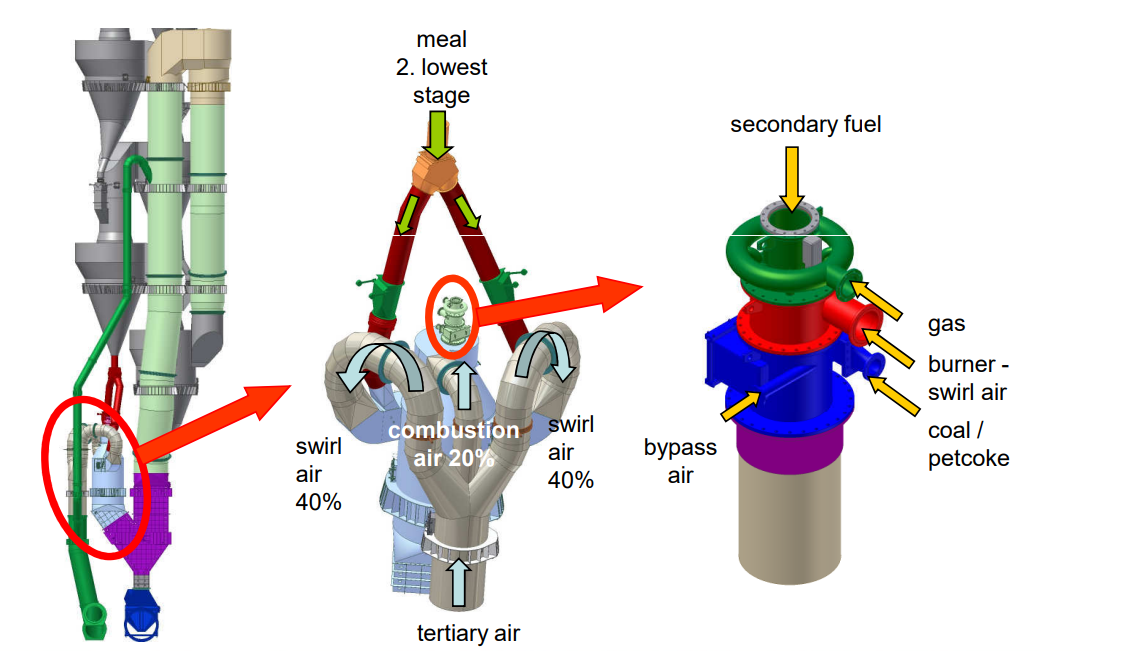Contents
10 Key Chemical Reactions in Clinker Production

TO Download this post and all the books and excel sheets and my personal notes and presentations I collected about cement industry in the last 30 years click the below paypal link
Clinker production is a critical step in cement manufacturing, involving a series of complex chemical reactions within a kiln. These reactions transform raw materials into clinker, a key ingredient in cement. Below is an overview of 10 essential chemical reactions that take place during clinker production, supported by references for further reading.
—
#### 1. **Decomposition of Calcium Carbonate (CaCO₃)**
The decomposition of calcium carbonate into calcium oxide (CaO) and carbon dioxide (CO₂) is the first significant reaction. This process is known as calcination and occurs at around 900°C.
**Chemical Equation:**
CaCO₃ → CaO + CO₂
**Reference:**
For an in-depth explanation of calcination, see *The Cement Plant Operations Handbook*
Link: www.cemnet.com/ebook
—
#### 2. **Formation of Dicalcium Silicate (C₂S)**
At temperatures around 1200°C, the reaction between calcium oxide and silica results in the formation of dicalcium silicate (C₂S), also known as belite.
**Chemical Equation:**
2CaO + SiO₂ → Ca₂SiO₄
**Reference:**
Detailed discussion on C₂S formation can be found in *Lea’s Chemistry of Cement and Concrete*
Link: www.sciencedirect.com/science/book/9780750662567
—
#### 3. **Formation of Tricalcium Silicate (C₃S)**
As temperatures increase to 1450°C, tricalcium silicate (C₃S), or alite, is formed through the reaction of calcium oxide with dicalcium silicate.
**Chemical Equation:**
3CaO + SiO₂ → Ca₃SiO₅
**Reference:**
The C₃S reaction is covered in *The Science of Cement*
Link: www.cementscience.com
—
#### 4. **Formation of Tricalcium Aluminate (C₃A)**
Alumina reacts with calcium oxide to form tricalcium aluminate (C₃A). This reaction occurs at approximately 1350°C.
**Chemical Equation:**
3CaO + Al₂O₃ → Ca₃Al₂O₆
**Reference:**
For more on C₃A, refer to *Cement Chemistry* by H.F.W. Taylor
Link: books.google.com
—
#### 5. **Formation of Tetracalcium Aluminoferrite (C₄AF)**
Iron oxide (Fe₂O₃) combines with calcium oxide and alumina to form tetracalcium aluminoferrite (C₄AF), contributing to the color of cement.
**Chemical Equation:**
4CaO + Al₂O₃ + Fe₂O₃ → Ca₄Al₂Fe₂O₁₀
**Reference:**
C₄AF is explained in the *Portland Cement Association’s Guide*
Link: www.cement.org
—
#### 6. **Alite (C₃S) Hydration**
Upon the addition of water, alite (C₃S) reacts to form calcium silicate hydrate (C-S-H) and calcium hydroxide, providing strength to cement.
**Chemical Equation:**
2Ca₃SiO₅ + 7H₂O → 3CaO•2SiO₂•3H₂O + 3Ca(OH)₂
**Reference:**
Hydration of C₃S is discussed in *Materials Science of Concrete*
Link: www.wiley.com
—
#### 7. **Belite (C₂S) Hydration**
Belite (C₂S) also hydrates slowly, forming calcium silicate hydrate (C-S-H), which contributes to the long-term strength of cement.
**Chemical Equation:**
2Ca₂SiO₄ + 5H₂O → 3CaO•2SiO₂•3H₂O + Ca(OH)₂
**Reference:**
For details on belite hydration, see *Cement and Concrete Research*
Link: www.journals.elsevier.com/cement-and-concrete-research
—
#### 8. **Tricalcium Aluminate (C₃A) Hydration**
When water is added, C₃A hydrates rapidly, producing an exothermic reaction and forming ettringite in the presence of gypsum.
**Chemical Equation:**
Ca₃Al₂O₆ + 6H₂O → C₆AH₁₈
**Reference:**
The hydration of C₃A is covered in *Hydration of Cement Compounds*
Link: www.springer.com
—
#### 9. **Formation of Calcium Hydroxide**
During the hydration of clinker phases, calcium hydroxide is formed as a by-product, which contributes to the alkalinity of cement paste.
**Chemical Equation:**
CaO + H₂O → Ca(OH)₂
**Reference:**
This reaction is explained in *Cement Hydration and Setting*
Link: www.cement.org/docs/default-source
—
#### 10. **Formation of Ettringite**
In the presence of sulfate, tricalcium aluminate reacts to form ettringite, an important phase for early strength development.
**Chemical Equation:**
Ca₃Al₂O₆ + 3CaSO₄ + 32H₂O → Ca₆Al₂(SO₄)₃O₁₂•26H₂O
**Reference:**
Ettringite formation is elaborated in *Structure and Performance of Cements*
Link: books.google.com
—
### Conclusion
Understanding these key chemical reactions is essential for optimizing clinker production and cement quality. For more details, you can explore the references provided with links to authoritative sources.
—
TO Download this post and all the books and excel sheets and my personal notes and presentations I collected about cement industry in the last 30 years click the below paypal link
